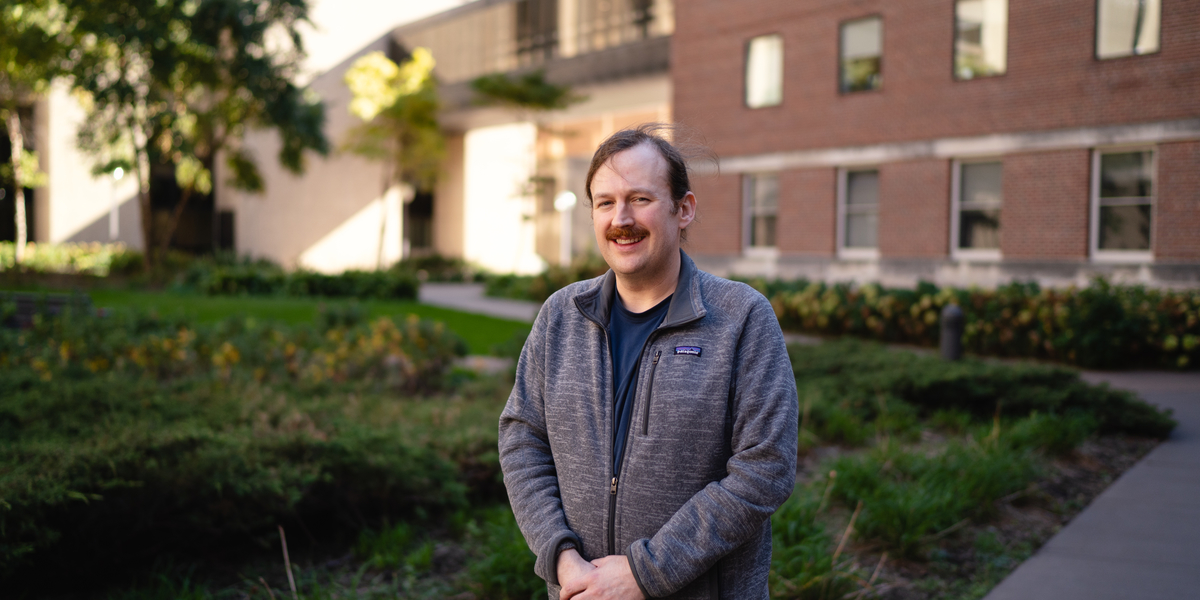
You may have been taught in school that nucleic acids, like DNA and RNA, hold the basic blueprints for all life. For many people, the science stops there. But what if these essential molecules do more than simply carry and transcribe genetic information? The topic has captivated Aaron Engelhart, an assistant professor in the Department of Genetics, Cell Biology, and Development, since he was an undergraduate at Arizona State University.
“At the time, my lab faculty advisor, Ian Gould, was trying to understand how DNA could potentially act as a wire, conducting electrons,” says Engelhart. Gould’s research eventually led to an increased understanding of DNA damage and repair — something that’s critical knowledge for applications like cancer treatment and gene therapy. And not long before Engelhart met Gould, other researchers discovered that RNA could act as an enzyme, a small protein that could catalyze other chemical reactions in the cell. “That was really unexpected,” says Engelhart. “It got people thinking nucleic acids might be able to do a lot more.”
Now, Engelhart is a leading expert in the field. He considers himself a biochemist whose lab seeks to identify new roles of RNA and either utilize them in human-engineered systems or discover their context in the natural world. Engelhart is particularly interested in what the diverse function of nucleic acids can teach us about the origins of life, astrobiology, cellular biology, and health. He’s also the recent recipient of two distinguished awards — one from the National Institutes of of Health and the other a National Science Foundation CAREER award. Both are funding him to deepen his current research, but with slightly different goals and trajectories.
“The NIH award is focused principally on finding new ways to detect and image nucleic acids,” says Engelhart. Despite numerous advanced technologies, it’s still difficult for scientists to observe how RNA works in increasingly complex settings — like living, breathing organisms. Engelhart hopes to utilize fluorescence to visually track nucleic acids by getting RNA molecules called aptamers to mimic fluorescent proteins by binding to dyes. Once the aptamers target the dyes, they are easy to spot under a microscope. He’s also hopeful to experiment with heme-derived fluorescent pigments to track RNA in model organisms, like bacteria, worms, and mice.
You might recognize heme as the iron-containing molecule that turns your blood bright red. It’s a molecule that’s ubiquitous and essential in the natural world. And as it turns out, heme may also be useful for RNA enzymes that can catalyze biochemical and mechanical reactions. Which is precisely what Engelhart is studying with the NSF CAREER Award. Precluding the award, he found that RNA can create a complex with heme. “These heme complexes can make a carbon-chlorine bond that's kind of new to RNA chemistry,” says Engelhart.
The unique findings in Engelhart’s lab keeps him on his toes. The process of understanding nucleic acids has also given him a fresh perspective on science — an ever-present reminder that our knowledge of the world is constantly evolving. “RNA is this molecule that keeps getting reinvented in biology,”says Engelhart. “It turns up in more and more systems, and that's made [my research topic] like an evergreen field. It makes it super fun to work on.” – Adara Taylor